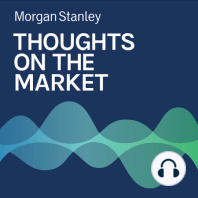3 min listen
The Evolution of Private Credit
ratings:
Length:
4 minutes
Released:
Mar 25, 2024
Format:
Podcast episode
Description
Morgan Stanley’s Chief Fixed Income Strategist explains why private credit markets have expanded rapidly in recent years, and how they may fare if public credit makes an expected comeback.----- Transcript -----Welcome to Thoughts on the Market. I am Vishy Tirupattur, Morgan Stanley’s Chief Fixed Income Strategist. Along with my colleagues bringing you a variety of perspectives, I'll be talking about the implications of the rapid growth in private credit for the broader credit markets. It’s Monday, March 25th at 12 noon in New York.The evolution of private credit is reshaping the landscape of leveraged finance. Investors of all stripes and all around the world are taking notice. The rapid expansion of private credit in the last few years has come against a much different backdrop in the public credit markets – a contraction in the high yield bond market and lackluster growth in the broadly syndicated loan market. What the emergence of private credit means for the public credit and the broader credit markets is a topic of active debate.Just to be clear, let me define what we mean by private credit. Private credit is debt extended to corporate borrowers on a bilateral basis or involving very small number of lenders, typically non-banks. Lenders originate and negotiate terms directly with borrowers without the syndication process that is the norm in public markets for both bonds and loans. These private credit loans are typically not publicly rated; they’re not typically traded in secondary markets; tend to have stronger lender protections and offer a spread premium to public markets.Given the higher overall borrowing costs as well the need to provide stronger covenant protection to lenders, what motivates borrowers to tap private credit versus public credit? Three key factors explain the recent rapid growth in private credit and show how private credit both competes and complements the public credit markets.First, small and medium-sized companies that used to rely on banks had to find alternative sources of credit as banks curtailed lending in response to regulatory capital pressures. A majority of these borrowers have very limited access to syndicated bond and loan markets, given their modest size of borrowings.Second, because of the small number of lenders per deal – frequently just one – private credit offers both speed and certainty of execution along with flexibility of term. The last two years of monetary policy tightening has meant that there was a lot of uncertainty around how high policy rates would go and how long they will stay elevated – which has led investors to pull back. The speed and certainty of private credit ended up taking market share from public markets against this background, given this uncertainty in the public markets.Third, the pressure on interest coverage ratios from higher rates resulted in a substantial pick-up in rating agency downgrades into the B- and CCC rating categories. At these distressed ratings levels, public markets are not very active, and private credit became the only viable source of financing.Where do we go from here? With confidence growing that policy tightening is behind us and the next Fed move will be a cut, the conditions that contributed to deal execution uncertainty are certainly fading. Public markets, both broadly syndicated loan and high yield bond markets, are showing signs of strong revival. The competitive advantage of execution certainty that private credit lenders were offering has become somewhat less material. Further, given the amount of capital raised for private credit that is waiting to be deployed – the so-called dry powder – the spread premium in private credit may also need to come down to be competitive with the public markets.So private credit is both a competitor and a complement to the public markets. Its competitive attractiveness will ebb and flow, but we expect its complementary benefit as an avenue for credit where public markets are challenged to r
Released:
Mar 25, 2024
Format:
Podcast episode
Titles in the series (100)
Mike Wilson: Are U.S. Economic Indicators Flashing Yellow? by Thoughts on the Market
